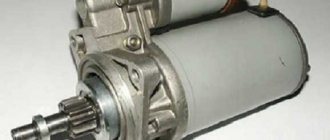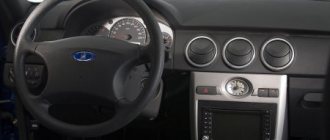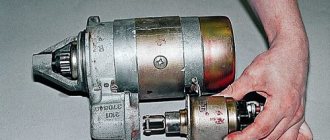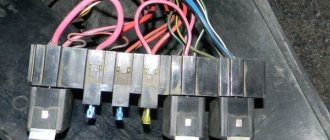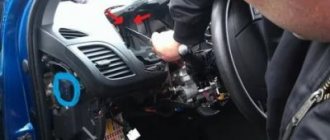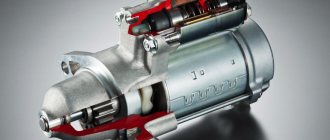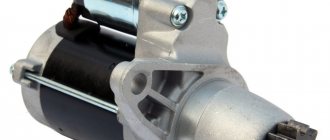It twists and doesn’t catch - what’s the reason?
A variety of factors prevent the starter from working correctly.
For example, this device usually causes a problem in winter because the engine oil thickens and the starter does not have enough power to turn the crankshaft.
However, if the starter turns idle, but does not catch, there are 5 main reasons.
Let's look at them:
- flywheel teeth wear out and no longer engage with the bendix;
- fork - breaks;
- the starter gear is warped and changes its position;
- power supply - wear of the solenoid relay, bushings or other parts of the starter;
- compression - absent or too low.
All this requires more detailed consideration.
What to do
Below are recommendations on what to do if you have a specific problem. Typically, it is better to entrust the repair of such faults to professionals at a service station.
1.Flywheel teeth. As a rule, the result of all this is the removal of the starter and a thorough inspection. After confirming the guess, not only the crown, but also the bendix itself is often replaced.
2.Fork. Usually, a car service center confirms the breakdown by testing the car, and only then proceeds to remove the starter. Dismantling involves disassembling the unit and reassembling all components. Serviceable parts are prepared for reinstallation, worn parts are replaced. After installing the fork, the starting device is subjected to a control test on the stand, and then on the car.
3.Gear. The distortion is being repaired. Again, the starter is removed and disassembled. After applying voltage from the battery to the starter terminals, the gear travel is tested. It should extend 0.3-1.5 mm. It is possible to adjust the part using spacer washers placed under the mount of the solenoid relay. The culprit for the misalignment may be the armature, or rather its bearings. Therefore, it is necessary to carefully check the condition of the bushings.
4.Power supply. Any electrical problem requires immediate repair. Otherwise, a short circuit may occur and damage the entire device. It is also necessary to check the fit of the brushes to the commutator, the condition of the solenoid relay and the armature commutator. Bushings must also be replaced if wear of parts is confirmed after inspection.
5.Compression. This term refers to the pressure created at the top point of the cylinder at the moment of compression. A low or absent value indicates a problem. It may require major repairs. However, sometimes it is possible to get by with little blood loss using special additives. For example, you can add a little synthetic oil. It will reduce friction and ensure a good start on a cold engine.
The procedure for replacing the Bendix depends on the type of starter. There are mechanisms with the so-called “beak” (more common) and without it. In the first case, the front part of the shaft is made in a single housing. In the second, it is installed in the crankcase.
The difficulty when installing a bendix is usually caused by the insertion of the support roller bearing. It is asymmetrical and equipped with a special wide chamfer that facilitates installation. If removed incorrectly, the backing is easily deformed, so it must be straightened before assembly. The part must be seated strictly without distortion.
Thus, when the starter does not engage the flywheel, you need to find the cause of the malfunction. If you can’t start the engine yourself, it’s better to call a tow truck and take the car to a car service center.
Source
Flywheel teeth
The flywheel wears out over time. The fastest thing to deteriorate is the crown that clings to the starter. Improper handling of the ignition key causes its teeth to grind down. This also happens due to constant loads.
In this state, the starter gear or overrunning clutch rotates idle, without clinging to the flywheel.
The flywheel teeth can be tested without dismantling the starter. Here's what to do:
- set the third or fourth speed;
- push the car half a meter forward - with the efforts of several people;
- try to restart the engine.
If the car starts, the crown will have to be replaced. This confirms the wear of any tooth. It is also possible that the teeth have worn off all over the circle, but this rarely happens.
Wear of flywheel ring teeth
Why doesn't the starter reach the crown?
Re: Why doesn't the starter reach the crown?
Ivan_OmsK » Thu Apr 10, 2014 12:02 am
Re: Why doesn't the starter reach the crown?
quattro » Thu Apr 10, 2014 12:43 am
Re: Why doesn't the starter reach the crown?
Sergey Samara » Thu Apr 10, 2014 11:29 am
Re: Why doesn't the starter reach the crown?
Ivan_OmsK » Thu Apr 10, 2014 3:26 pm
Re: Why doesn't the starter reach the crown?
Sergey Samara » Thu Apr 10, 2014 4:34 pm
Re: Why doesn't the starter reach the crown?
Vovan1982 » Thu Apr 10, 2014 4:45 pm
Re: Why doesn't the starter reach the crown?
Vovan1982 » Thu Apr 10, 2014 4:45 pm
Re: Why doesn't the starter reach the crown?
by vadik89 » Sun Apr 13, 2014 8:14 pm
Re: Why doesn't the starter reach the crown?
by vadik89 » Sun Apr 13, 2014 8:20 pm
Re: Why doesn't the starter reach the crown?
quattro » Sun Apr 13, 2014 9:29 pm
Fork failure
The starter fork is a special lever made of plastic or metal material. Participates in the transmission of force from the solenoid relay to the starter. Failure of this part makes it impossible to start the engine, since the overrunning clutch does not extend.
Frequent reasons why the plug breaks:
- wear of fastening parts - the situation is especially difficult with a plastic fork, since ground pins can be impossible to weld and the entire element has to be replaced;
- overheating of the starter - due to jamming of the overrunning clutch or faulty contacts, the starter does not turn off after starting the engine and breaks the plug;
- overexposing the ignition key has the same result, but the part is already damaged due to the human factor.
Broken starter fork
It is noteworthy that on modern cars, which have excellent sound insulation, starter forks break more often. Why? The fact is that the driver simply does not notice the engine starting and continues to turn the key.
Hydraulic
Hydraulic starter
Some six to 16 cylinder diesel engines are started using a hydraulic motor. Hydraulic starters and associated systems provide spark-free and reliable engine starting over a wide temperature range. Typically hydraulic actuators are used in applications such as remote generators, lifeboat motors, marine fire pump motors, and hydraulic fracturing rigs. The system used to support the hydraulic starter includes valves, pumps, filters, reservoir and piston accumulators. The operator can manually prime the hydraulic system; this cannot be easily accomplished with electric starting systems, so hydraulic starting systems are preferred in applications where emergency starting is required.
Hydraulic starters of various configurations can be installed on any engine. Hydraulic starters use the high efficiency axial piston motor concept, which provides high torque in any temperature and environment and ensures minimal wear on the motor ring gear and pinion.
Gear misalignment
If the starter turns but does not engage the flywheel, the Bendix gear may be in the wrong position. The reason is deformation of the supporting spring. As a rule, such a malfunction leads to the fact that the clutch only comes into contact with the flywheel crown. High-quality engagement does not occur, which is accompanied by unpleasant sounds - clanging and grinding.
Holding the key in the active position for a long time will not lead to anything good. Therefore, the rotation of the starter must be stopped, otherwise there is a risk of breaking various parts of the starter, even cutting off the gear teeth.
Another factor in gear misalignment is banal metal actuation or fatigue. The part gradually grinds down and less often accurately engages with the crown, which leads to an increase in load. This increases wear even more. Due to impacts on the flywheel surface, the overrunning clutch loses its original position.
Bendix gear misalignment
Price issue
Finally, it’s worth adding that Bendix is an inexpensive spare part. For example, a Bendix VAZ 2101 (as well as other “classic” VAZs) costs about $5...6, catalog number is DR001C3. And the price of Bendix (no. 1006209923) for VAZ 2108-2110 cars is $12...15. The cost of Bendix for FORD cars of the Focus, Fiesta and Fusion brands is about 10...11 $. (cat. no. 1006209804). For TOYOTA Avensis and Corolla cars Bendix 1006209695 - $9...12.
Thus, repairs are often impractical for Bendix. It's easier to buy a new one and simply replace it. Moreover, when repairing individual parts, there is a high probability of rapid failure of others.
The reason is the power supply
There is also no need to rule out a malfunction of the electrical component of the car. A problem may occur in the solenoid relay. It is installed on the starter and is a magnet made of two coils.
- One of the windings is retractable - it extends the gear and closes the contacts to supply current to the starter brushes. Integrated with the control terminal and directly with the electric motor.
- The second coil creates additional force so that the overrunning clutch receives reliable engagement with the flywheel. That's what it's called - holding. Connects to control pin and housing.
Common malfunctions of this part are: complete combustion of one or both windings, wear of the nickels (contact plates), destruction of the return spring or armature, interturn short circuit of the starter. In any case, the bendix is not locked and rotation is not supplied to the car engine. This is the reason that the clutch spins idle - it does not engage with the flywheel. A faulty relay is usually replaced, since the windings are rarely repairable.
Testing the pull-in coil of the relay with a multimeter
Another difficulty relates to the starter itself. It is often repairable; its removable parts are easily replaced - brushes, armature, stator. But the most common reason when a car does not start is due to worn bushings.
Bushings are rolling bearings that hold the armature on both sides. When they are severely worn, the rotor begins to play, its position changes, as a result of which it sticks. Hence the starter's idle operation.
This is what happens specifically, and quite often on modern cars, when the starter operates on worn bushings:
- the electric motor begins to require more voltage;
- because of this, the current in the vehicle’s on-board network sharply decreases;
- the voltage drops below 9, and then the ECU turns off;
- the system does not generate a spark, the starter turns the shaft, but the internal combustion engine does not start.
Of course, the bushings are also replaced. But it’s even better, if possible, to replace the entire starter - especially if it has been working for a long time.
Popular brands:
Mitsubishi Lancer
Inoperability
Not the starter, but the bendix does not engage the flywheel. This is how you need to understand the problem. Let's look at the reasons why this might happen.
- If the mechanism does not lock on the starter shaft. This is often caused by the fact that over time, the rollers with springs wear out and are no longer able to provide reliable engagement.
- Hardening of the grease is also a common cause of this problem. It simply turns into a thick lump, limiting the movement of the Bendix roller-spring system. As a result of this, no engagement occurs. A common cause of grease hardening is dirt or dust getting inside the starter.
- It is also possible that the bendix teeth or flywheel ring are worn out. In this case, there will also be no engagement. If the problem is in the crown, then it is simply replaced with a new one. The same is done with Bendix, which is being updated.
It will be useful to know that some types of starters are equipped with a plastic Bendix drive. This means that such a product breaks easily, and starting the internal combustion engine becomes impossible.
Flywheel ring teeth worn
It will also be important to note that the operational service life of the starting system depends on the number of engine starts performed. The more there are, the less resource the mechanism has left.
And most often, problems with starting, i.e., engagement of the starter and flywheel occur in passenger vehicles (buses, minibuses, taxis).
If you operate the machine correctly and follow the basic rules of proper engine starting, especially in cold weather, the service life of the device can be significantly increased
Of no small importance here, of course, is the overload of the starter and other elements of the starting system
Low compression
Finally, if the starter turns but does not start, the engine may be the cause. This occurs due to low compression, which usually occurs in the morning or in cold weather. The pressure is insufficient to compress the fuel mixture, so the internal combustion engine does not start. In addition, the crankshaft rotates with resistance, which also complicates starting.
Weak compression also occurs for the following reasons:
- There are burrs on the cylinders;
- there is a problem with the piston rings;
- block gasket burnt out;
- cylinder head cracked;
- Timing valves are leaking.
It is noteworthy that in some cases adding a small amount of oil will help increase compression. It is desirable that it be a synthetic composition.
In some situations, a special type of additive is used (more on this below).
Some tips from experienced drivers
Here are some tips from experienced motorists that will help you avoid possible problems and inconveniences when repairing or replacing a Bendix:
- Before installing a new or repaired bendix, always check its operation and the drive of the unit.
- All plastic washers must be intact.
- When buying a new Bendix, it is advisable to have the old one with you in order to verify their identity. Often similar parts have minor differences that are not visually memorable.
- If you are disassembling a Bendix for the first time, it is advisable to write down the process on paper or put the individual parts in the order in which they are dismantled. Or use the manual with photographs, video instructions above, and so on.
Electric car starter: principle of operation and malfunctions
A car starter is an attachment to a vehicle that is necessary to rotate the engine crankshaft to start it. The starter itself (part of the electric engine starting system) is actually a DC electric motor, powered by the battery.
At the same time, during the operation of the vehicle, quite often problems with starting the power plant arise precisely because of the failure of the vehicle starter. In this article we will look at the main faults of the starter, as well as why the starter does not turn off after starting the engine.
Starting system for a modern car
Today, motorists have a much easier time than several decades ago, when the car was started with a crank. In those days, one could only dream of starting the engine from inside the car.
Nowadays, it is enough to insert the key into the ignition or press a special button for the car to start. But problems also occur in this case, if the nodes, so to speak, “get sick.” No matter how modern a car is, over time it becomes outdated, and more and more problems arise.
One of them just implies poor engagement of the flywheel by the starter. Why does this happen? Experts, as soon as the topic comes up, mention the problem of the overrunning clutch or bendix.
Purpose of Bendix in a car
Bendix
Overrunning clutch is a gear mechanism capable of transmitting anchor rotation to the engine flywheel. Thus, the engine starts.
Attention. A prerequisite for trouble-free operation of the components of the automotive system is the removal of the bendix after the engine has been successfully started.
You should know that a clutch is not just a gear, but a mechanism that also develops malfunctions.
To more fully understand the cause of the problem with the flywheel engaging, it will be useful to consider the general principle of operation of the entire starting system.
The starter is a DC electric motor. In some cases, it develops much more power than required. Thus, it becomes possible to run the internal combustion engine with maximum displacement.
In a modern starter, an important role is played by a relay - a special unit that brings the clutch into contact with the flywheel some time before the armature false start. Then only voltage is applied to the starter winding, after which it begins to rotate the crankshaft of the car engine.
The rotation of the crankshaft becomes a source of compression of the combustible mixture, followed by its ignition. As soon as this happens at the right moment, the internal combustion engine begins to function automatically.
At this very moment, the metonymic cycle of the flywheel begins to dominate the revolutions of the starter shaft (armature), and the bendix is already engaged. As soon as the driver turns off the car, the starter shaft no longer rotates, and the traction drive disengages the clutch.
It is important to understand that the bendix itself consists of 2 parts: upper and lower (HFB and LFB). The latter acts in the form of a hollow shaft having two different calibers. One of the parts of the shaft is equipped with splines that transmit rotation of the starter, and the other part contains a cage with rollers.
Videos in analysis
There is no interaction between the videos and the NCB initially. It occurs only after, when the first revolutions appear. The rollers are brought to the middle, thereby limiting the shaft. This happens in such a way that the shaft can only rotate in one direction. The rollers, thanks to their springs, do not allow them to rotate in the other direction.
Once the flywheel gains speed, it will be able to rotate the bendix. In this case, the rollers move apart, opening the stopper. The gear mechanism returns to its primary position.
Bendix often freezes in the mornings when it is cold. Experienced drivers recommend cranking the starter several times, thereby heating the bendix and enabling its operation.
The design of a car engine starter and its operating principle
The main components of the starter:
In a nutshell, a flywheel with a ring gear is installed on the engine crankshaft. When the starter is turned on, the starter gear meshes with the flywheel crown and the electric motor turns the crankshaft. After the engine starts, the starter overrunning clutch disengages the gear from the shaft when the engine speed exceeds the starter speed.
The solenoid relay is an electromagnet with a coil and a core. The core, under the influence of the electromagnetic field, begins to move to the side, while the fork connecting the core and the bendix pushes the bendix and gear along the shaft forward to engage it with the flywheel.
The relay has two contacts, one of which is supplied with voltage from the battery, and the other is connected to the brushes of the electric motor. When the core reaches the end of the relay, with the gears already engaged with the flywheel, the copper plate located at the end of the core closes these two contacts and voltage flows to the electric motor.
As for the types of starters, there are:
In this case, starters may differ from each other, but not significantly. In most cases, their difference lies in the mechanics of automatic gear disengagement.
It usually takes a few seconds for the engine to start. But in practice, malfunctions may occur when, after the first turn of the key, the engine does not start, after starting the engine, the starter spins along with the engine, etc.
How to replace Bendix
You can replace the Bendix in literally 10-15 minutes. With the condition that the starter has already been removed from the car and prepared for repairs. First, unscrew the rear cover fasteners, then remove the locking ring from the rotor. Unscrew the two nuts that secure the starter parts. But it can be disconnected only after the stator windings are disconnected from the brush assembly. When repairing starters, try to pay attention to all the details, even the smallest ones.
First, clean the slats and body. Secondly, evaluate the wear of the bushings and brushes. When you disconnect all the starter parts, the rotor will remain in the front cover. Closer to its edge there is a locking ring. A clip is placed on top of it, which can be moved towards the rotor winding by applying a few light blows. After this, use a screwdriver to remove the ring. That's all, now the bendix can be easily dismantled, and a new one can be installed in its place. It is recommended to coat the spiral splines on the rotor surface with lithol or graphite lubricant.
